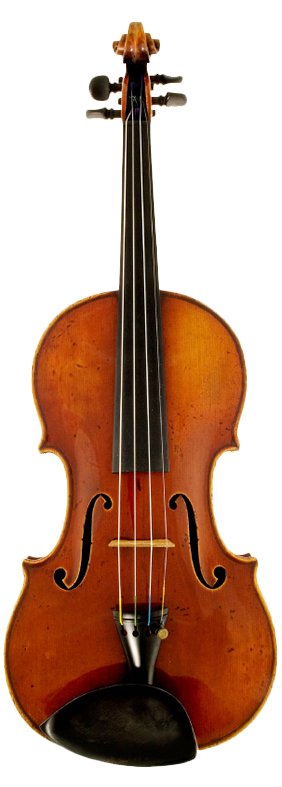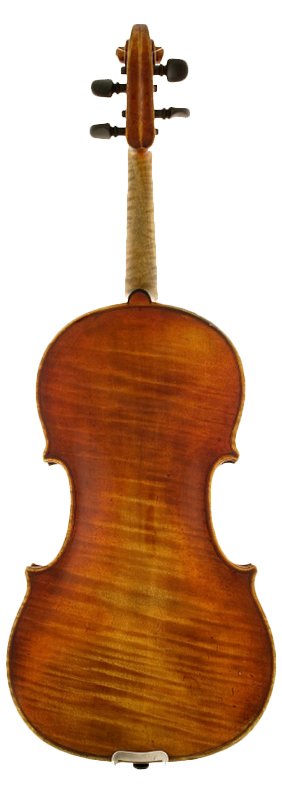The beginning of the nineteenth century saw a dramatic renaissance in the art of violin making. But it did not happen in Cremona. The focus shifted north, to Turin. But it was also an odd confluence of French and Italian craftsmen who brought about the definitive change from the comparatively degenerate work of the late eighteenth century. The post-revolutionary Paris school of violin makers, headed by Pique and Lupot, were pioneers in developing Stradivari's designs and precise workmanship for the new century. These ideas were probably transmitted to Turin with the help of Napoleon's army, which from 1796 to 1802 occupied Piedmont, and maintained Turin under Napoleonic control until 1815.


Giovanni Francesco Pressenda was born in 1777 in the village of Lequio-Berria, near Alba in Piedmont. His assistant and first biographer, G.F. Rinaldi, wrote that Pressenda encountered the Cremonese maker Lorenzo Storioni at the age of about 12. It is certainly true that Storioni was absent from Cremona for the last decade of the century, and it is quite possible that the two met in Turin. Rinaldi insists, however, that Pressenda remained in Alba until 1814 at least. In 1817 he moved to Carmagnola, south of Turin, and finally arrived in Turin itself by 1822, when his own labelled instruments from Turin seem to commence. By this time, the city was changing rapidly from the old French regime, and forging a new Italian identity, with the 'Risorgimento' and the re-establishment of the old House of Savoy. As part of this, great expositions to promote the agriculture and industry of the region were promoted. 1829, at the age of 52, Pressenda entered two violins in the first Exposition held in the city. He shared the 'copper medal' with Alessandro d'Espine, who is described in the documentation as the Dental Surgeon to His Majesty Carlo Felice' (Carlo Felice was the Duke of Savoy and King of Sardinia from 1821 to 1831). Pressenda himself is formally described at that stage as being a resident of Turin. D'Espine was to say the least an important early influence, more so than any Storioni connection. D'Espine was older than Pressenda, born in 1775, and an active maker in Turin since 1815, having possibly arrived there with the French forces. Another influence that should not be overlooked was Gaetano Guadagnini, the younger son of G. B. Guadagnini, who died in Turin in 1778. Gaetano lived in Turin until his death in 1831, and Pressenda, Rocca and d'Espine would surely have been aware of him and his father's reputation. However, the direct impression of Guadagnini is as hard to detect in any nineteenth century Turin work as that of Storioni. In 1832 Pressenda entered another exposition, this time gaining a silver medal for two violins and a cello, and here his address in Turin is found for the first time, at 30, via d'Angennes.
1840 marked the death of Count Cozio di Salabue, another Piedmontese and an avid collector of fine instruments. It is not known whether he had any specific contact with Pressenda, of a sort that might have influenced his making, but Cozio's interest seems to have been waning for some time already. The best part of his collection remained in Piedmont however, passing to Luigi Tarisio. Tariso was also Piedmontese, although living in Milan for the greater part of his life, and it is clear that the instruments which passed from Cozio to Tarisio, which included the 'Messie' Strad and the 'Alard' del Gesu, had a great effect on the work of Pressenda's pupil Giuseppe Rocca.
Rocca probably knew Pressenda from quite an early age. Born in 1807 in Barbaresco, very close to Pressenda's home, they probably worked together almost from the start of Pressenda's career in Turin. By the late 1830s, Rocca was a very important contributor to the workshop production, and it must have been difficult for Pressenda when he left. This must have happened before 1844, Rocca having occasionally labelled his own work from 1838, but both Pressenda and Rocca made separate entries to the fourth Turin exposition held in that year, marking a significant parting. Pressenda, by this time 67 years old, won another silver medal. At this point it is probable that Pressenda brought in Pierre Pacherel as his assistant to replace Rocca. Pacherel marks another important French connection. A member of an old Mirecourt violin making family, he was apprenticed there with the young J.B.Vuillaume. Working in Nice in the 1830s, he was employed by Pressenda in Turin until about 1849. From the evidence of his own unaided work produced later, back in Nice, Pacherel was an able craftsman capable of carrying out most of Pressenda's work, with the exception of the varnish. It is also possible that another Turin maker, Nicola Bianchi, contributed at some time in this period. He departed for Paris in 1842, but ended his career in Nice, following Pacherel.
The fifth Turin exposition came in 1850, by which time Pressenda was 73, but nevertheless, he was presented with a 'gilded silver medal' for his work. By this time he was assisted by his biographer, Gioffredo Benedetto Rinaldi. Four years later, he died at his home on the via d'Angennes.
The practice of holding these industrial and craft expositions, as well as the burgeoning musical culture of conservatoires and public concerts that marked the era provided Pressenda with a great opportunity to make instruments of prestigious quality. His working life, starting at the relatively late age of 45 in 1822 to his death in 1854 produced a wealth of fine instruments that brought the tradition of violin making back in line with the finer ambitions of the great Cremonese.
In structure, his work does not show a close familiarity with the techniques of Stradivari, but a very good understanding of the aesthetic principles and high standards of craftsmanship that he represented. The outlines he used are 'Stradivarian', but probably not derived exactly from a close analysis of any one instrument, as his pupil Rocca was to do later on. The early models have a slightly boxy quality, but from 1830, there is a consistent outline that does seem to owe a lot to the 'P' mould of Stradivari. Count Cozio di Salabue was in possession of much of the Stardivari workshop relics at this time.
The interiors are constructed, like Stradivaris, from willow, but the linings are not morticed to the blocks. The corner blocks are carved deeply into a shallow 'v' section, and sometimes show the traces of a transverse knife cut, some 12 mm up from the back plate, which probably mark the level of the mould. Pressenda habitually used beech for the purfling, with conventional dyed fruitwood for the very thin black strips, which follow the outer edge of the corners into exagerratedly long bee stings, very much in the style of Lupot. The fluting around the soundholes is sometimes disappointingly crude, with a large 'crater' edge formed around the lower hole. On the scroll, the distinctive feature is the deep scribe line tracing the centre of the fluting, which appears on most subsequent Turin work. Pressenda also copied the blackened chamfer of Stradivari's golden period.
A lot of his career seems to have been taken up with the challenge of varnish, which changes in character considerably throughout his life. Early examples have a rather scratchy, one-dimensional red varnish, which changes to a heavier coating which penetrates the wood quite deeply, giving a slightly stained appearance in some areas, and the 'reverse grain' effect in the top wood. By the 40s he seems to have developed a good, deep and complex coating closer to the ideal of Classical Cremona. The colouring can be orange-brown to deep red, and sometimes the deep texture is broken by quite strong craquelure. The ground is generally of a gold or yellow tint.
Needless to say, Pressenda's work is now highly valued, and as might be gathered from all the above, represents a fine balance between the earlier Italian school and the rigorous standards of the new French-led nineteenth century style. His workmanship is thorough and very well finished, but is not without markers of individuality and his own style. His legacy is strong in the work of his pupils, Rocca, and to a lesser extent Rinaldi and Pacharel.